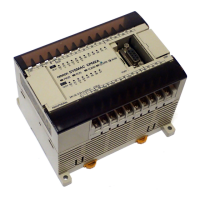Glossary
42
I/O word A word in the IR area that is allocated to a Unit in the PC System.
IR area A data area whose principal function is to hold the status of inputs coming
into the system and that of outputs that are to be set out of the system. Bits
and words in the IR that are used this way are called I/O bits and I/O words.
The remaining bits in the IR area are work bits.
ladder diagram (program) A form of program arising out of relay- based control systems that uses cir-
cuit- type diagrams to represent the logic flow of programming instructions.
The appearance of the program is similar to a ladder, and thus the name.
ladder diagram symbol A symbol used in a ladder- diagram program.
ladder instruction An instruction that represents the “rung” portion of a ladder- diagram pro-
gram. The other instructions in a ladder diagram fall along the right side of
the diagram and are called terminal instructions.
LOAD instruction Starts the operation of a line of programming. Each new line off the bus bar
has an address number, a LD instruction, and a relay number.
LR area A data area that is used in a PC Link System so that data can be transferred
between two or more PCs. If a PC Link System is not used, the LR area is
available for use as work bits.
Master Short for Remote I/O Master Unit.
normal condition A condition that produces an ON execution condition when the bit assigned
to it is ON, and an OFF execution condition when the bit assigned to it is
OFF.
OFF The status of an input or output when a signal is said not to be present. the
OFF sate is generally represented by a low voltage or by non-conductivity,
but can be defined as the opposite of either.
OFF delay The delay between the time when a signal is switched OFF (e.g., by an input
device or PC) and the time when the signal reaches a state readable as an
OFF signal (i.e., as no signal) by a receiving party (e.g., output device or
PC).
ON The status of an input or output when a signal is said to be present. The ON
state is generally represented by a high voltage or by conductivity, but can be
defined as the opposite of either.
ON delay The delay between the time when an ON signal is initiated (e.g., by an input
device or PC) and the time when the signal reaches a state readable as an
ON signal by a receiving party (e.g., output device or PC).
operating error An error that occurs during actual PC operation as opposed to an initializa-
tion error, which occurs before actual operations can begin.
OR A logic operation whereby the result is true if either of two premises is true, or
if both are true. In ladder-diagram programming the premises are usually ON/
OFF states of bits or the logical combination of such states called execution
conditions.

